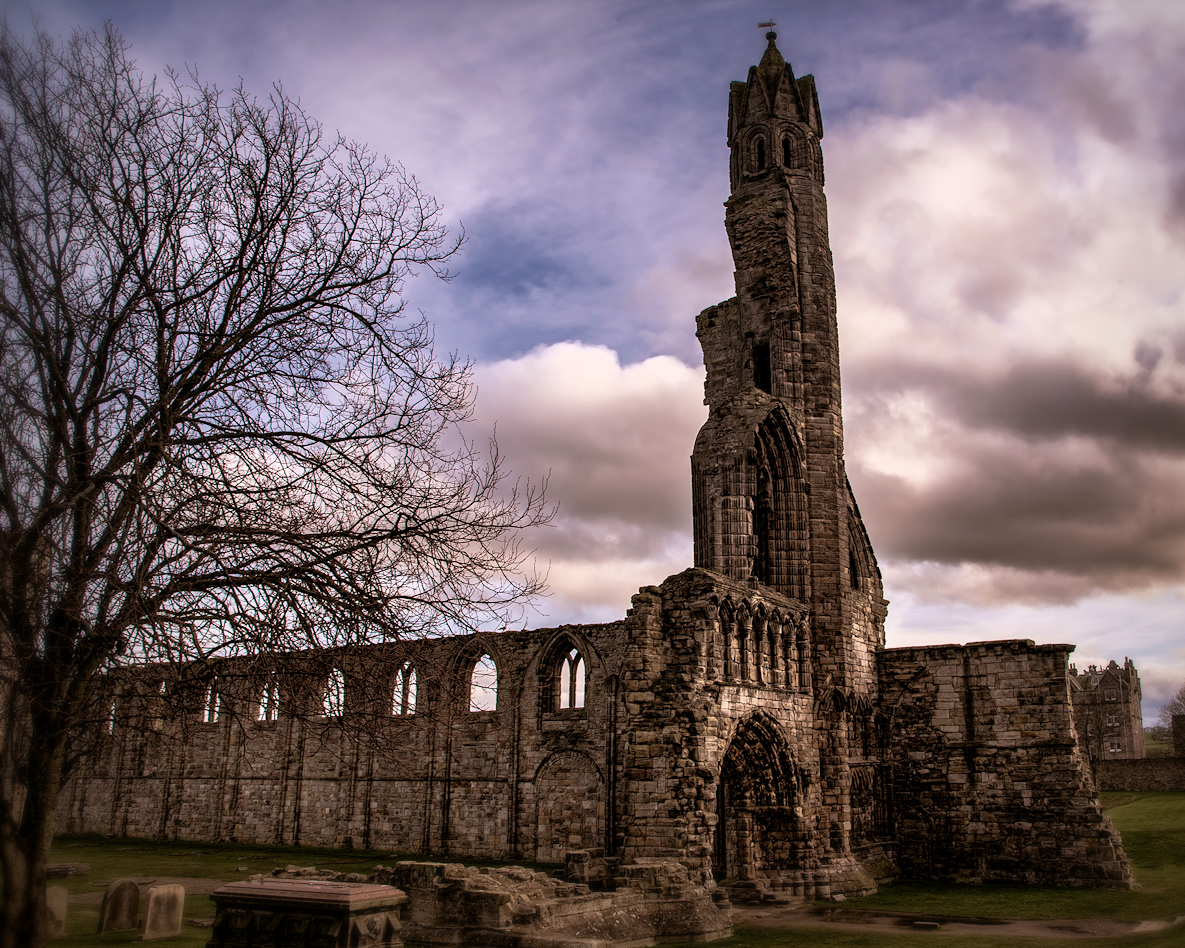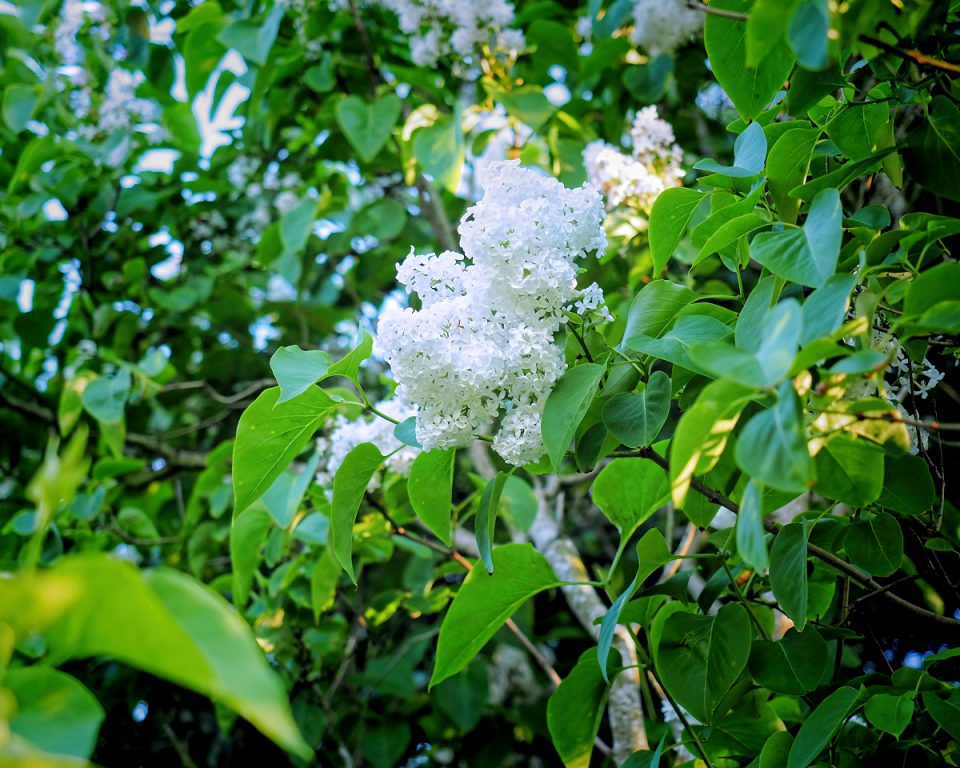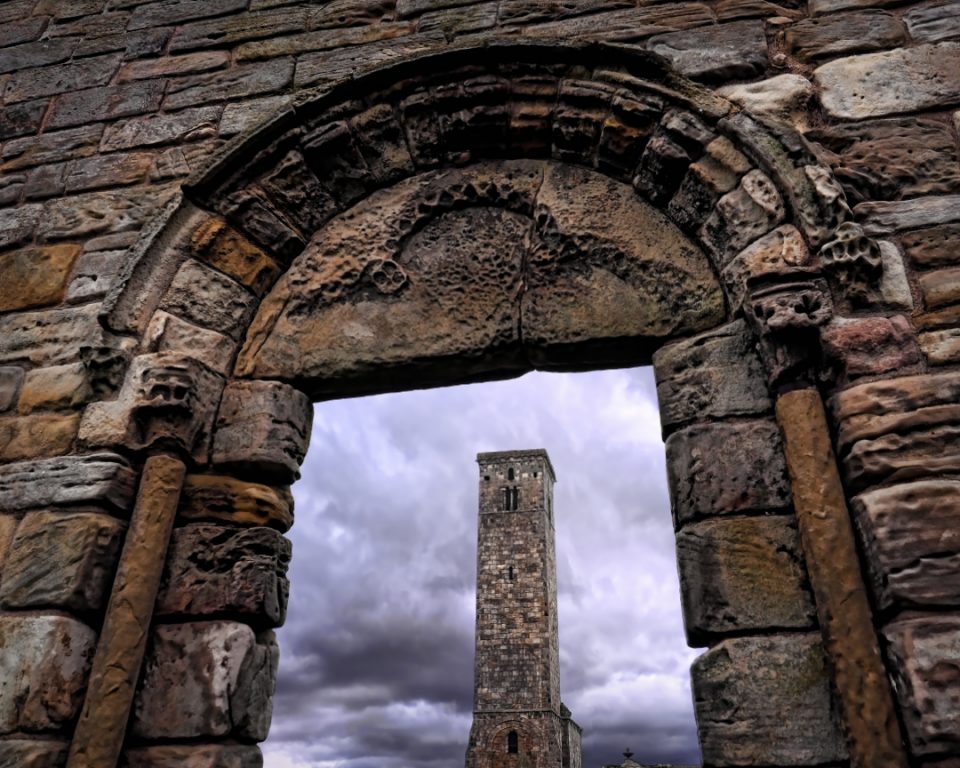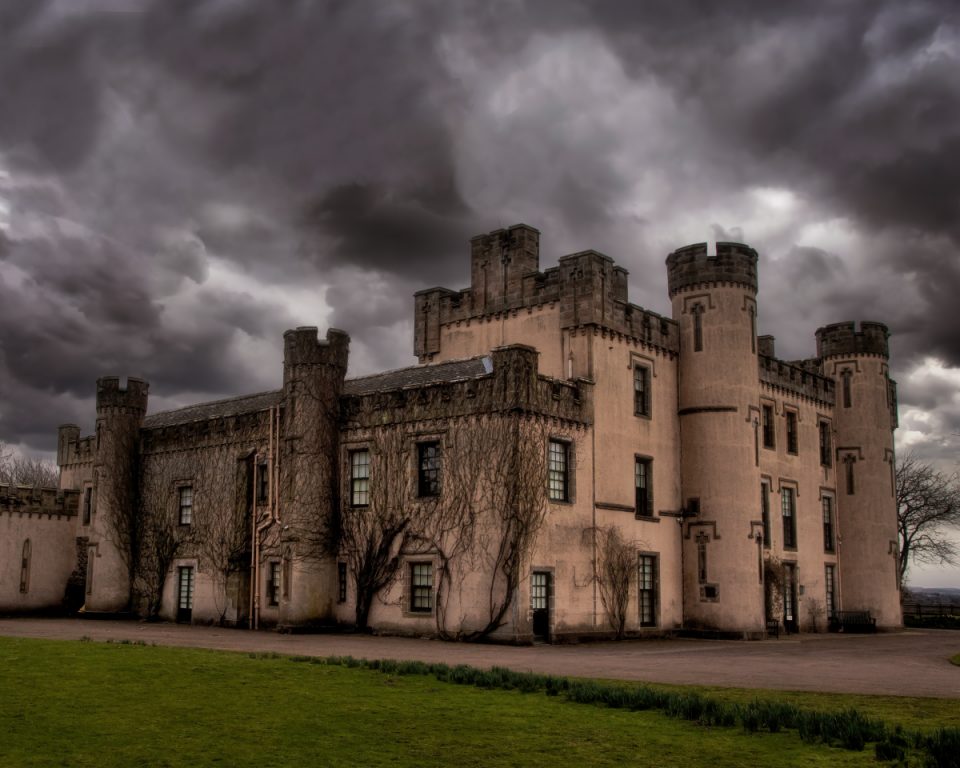St Andrews Cathedral is the place to visit if you are interested in stones, bones, and ghostly groans. Like all of Scotland’s ancient buildings, it is shrouded in its fair share of myth and mystery. How could it be anything less when it once housed the bones of Scotland’s Patron Saint, Saint Andrew whose feast day is celebrated on 30th October?
The museum at St Andrews Cathedral can boast a huge array of stones. From Pictish cross-slabs, a Viking Hogback to many post-reformation tombstones, the broad timescale of this collection makes this particularly special. The quality of the post-reformation tombstones, themselves is exceptional. Their carved skulls and skeletons make them a veritable feast in the macabre.
However, the piece de resistance must surely be the exquisitely carved Pictish sarcophagus, one of the finest examples of Pictish artwork there is.
Kilrimont
In the dark mists of time, St Andrews was known by another name: Kilrimont or Cennrigmonaid. This is Gaelic for the ‘Church on the King’s Hill.’
It seems that there had been a religious settlement upon the promontory in Fife long before the nation of Scotland was born. North of the Firth of Forth was dominated by two groups of people: the Gaels of Dal riata in the west and the Picts in the east. It might, therefore, seem strange that a Pictish settlement should be given a Gaelic name. Probably, it did have a Pictish name, but it has been long forgotten, along with the whole Pictish language.
It should be remembered that the Gaels were the first of these people to be converted to Christianity and missionaries like Columba spread the ‘word’ to the neighbouring Picts. For a long period of time, the administrative centre of the Celtic church was based in the Isle of Iona, deep in the Gaelic heartland. It seems that the Gaelic influence spilt over into the religious worship of the early Christian Picts.
Saint Andrew’s Relics
According to an old legend, the founder of the original monastery at Kilrimont was instituted on the command of a Pictish king named ‘Hungus’. This is likely to be Oengus I. A group of Culdee monks, a Holy Order within the Celtic Church, built a chapel and a monastery on the site. They were commissioned to look after St Andrews bones or relics.
It is thought that St Andrew’s relics were brought to Kilrimont by the Northumbrian Bishop Acca of Hexham. Bishop Acca had been on a Pilgrimage to Rome and may have acquired the relics at some point during his travels. However, according to popular legend, a monk named Saint Rule or Regulus was commanded in a dream to carry St Andrew’s bones to the ‘edge of the world’. He set off by boat in 347 A.D from Patras in Greece before being shipwrecked near the site of today’s harbour at St Andrews.
The arrival of the relics was to change Kilrimont’s future. It would go on to become the main power base of the Scottish church throughout the Dark Ages. It was a role which had formerly centred around Iona. However, due to Viking activity in the Island’s vicinity, Saint Columba’s bones were moved to the mainland in 849 A.D. for safekeeping. They would eventually find a home in Arbroath Abbey and were later carried into battle at Bannockburn.
Interestingly, the chapel the Culdees built at St Andrews was dedicated to Saint Rule.
The Arrival of Augustinian Canons
Many years later, after the nation of Scotland had been formed, Malcolm Canmore came to power. He married an Anglo-Saxon Princess named Margaret. Queen Margaret decided to overhaul the Celtic Church in Scotland, bringing it in line with the rest of the Catholic Church. She was canonised in recognition of her efforts. However, this meant that the Culdees power was waning.
Then in 1130, Malcolm and Margaret’s son David I, King of Scots appointed the newly arrived Augustinian Canons as guardians of St Andrew’s bones. They supplanted the Culdees and extended the Church of St Rule. Today all that remains of this church is a 100ft tower. The views from St Rule’s Tower are stunning but beware! The ghost of Prior Robert de Montrose might walk straight through you as you ascend to the top!
The Culdees were pushed onto the land on the northeastern fringes of the rocky promontory. There they built the Church of St Mary on the Rock.
The Building of St Andrews Cathedral
The Augustinians were ambitious and in 1160 Bishop Arnold dreams came true; he was granted permission to begin building St Andrews Cathedral. This would be no ordinary building. This was going to be Scotland’s largest cathedral. However, the elements it would seem would conspire against the stonemasons. The headland was exposed to all the vagaries of the Scottish weather and the bitter chill blast of the North Sea. In 1270 the west end of the nave was blown over by a gale.
Then, during the Scottish Wars of Independence, the incumbent Bishop of Saint Andrews, William Lamberton, played an influential role in championing the cause of both William Wallace and later Robert the Bruce. Indeed, he had crowned Bruce along with Bishop Robert Wishart of Glasgow. This act of defiance would not be ignored. As a result, the English stripped the lead from the part-built roofs and Lamberton found himself excommunicated from the church.
The Rise and Fall of St Andrews Cathedral
Eventually, St Andrews Cathedral was consecrated on the 5 July 1318 in the presence of Robert the Bruce, some 150 years after building had commenced. Disaster would soon strike again. In 1378 the cathedral was badly damaged by fire. Then in 1409, the south transept collapsed during a winter storm.
Alas, the death knell for cathedral came in the form of a sermon given by the great leader of the Scottish Protestant Reformation, John Knox. Those embracing the new ideas had had a particularly hard time in St Andrews. Patrick Hamilton was to be the first martyr in the Protestant Reformation and was burnt at the stake outside St Andrews’ St Salvator’s College. Less than 20 years later George Wishart would meet a similar fate at the hands of the infamous Cardinal Beaton.
On the 11 July 1559, Knox preached a fiery sermon in St Andrews parish church and incited the local congregation. Vengeance burnt in their bellies. This new religion was unmerciful. They set off immediately to ‘cleanse’ the cathedral, ripping apart the fittings and furnishings in an act of wanton vandalism. By the end of the week, the friars had been violently cast out of St Andrews. St Andrew’s relics were destroyed as they were seen as ‘popish idolatry’.
The Cathedral was left to crumble and decay. Exposed to the elements it soon fell into ruin. The neighbouring people took advantage of the situation, using the falling walls as building material for the town of St Andrews which had grown up around the Cathedral.
The St Andrews Sarcophagus
Although the Cathedral had fallen into ruin, the land around it was still used as a graveyard. In 1833, the gravediggers stumbled upon an amazing discovery. They unearthed several pieces of sculpted stone. It soon became evident that these were the broken remnants of an ancient coffin or sarcophagus. A subsequent search revealed some larger pieces. It was obvious that this was no ordinary grave. The quality and detail of the carving was simply exquisite. This was a coffin fit for a king!
It seems that the sarcophagus dates from the mid-700s and is one of the most impressive of all Pictish monuments. On the side panel is a woodland hunting scene. A scene from the Bible is depicted with King David defending his flocks from a lion.
The occupant of the burial shrine remains a mystery. However, the chief candidate is Onuist or Oengus I who died in 761. He was a mighty warlord who dominated North Britain during his reign and successfully conquered the Gaelic Kingdom of Dal riata.
The identity of the coffin’s original owner is not the only mystery connected with it. The freshness of the design suggests that it has not been subjected to weathering. It seems that it was originally housed in a building but was soon after buried in the ground next to Saint Rule’s church. Why would this beautiful tombstone need to be hidden away? Today the Sarcophagus is on display in the Museum at St Andrews Cathedral. The museum occupies the vaulted undercrofts of what once was the priory.
Viking Hogback
Included in the collection of stones in the museum is a Viking Hogback. Although they were made and used by Vikings, they only appear to have been in use in Britain. These recumbent stones are small replicas of Viking Long Houses. Regarding hogback stones, Professor Stephen Discoll of Historical Archaeology at Glasgow University has stated:
“My feeling is that this is meant to represent a lord’s hall or a chieftain’s hall.
“This type of monument, these hogback monuments, you only find them in Britain. You don’t get them in Scandinavia, and you don’t get them before the Vikings come here.
“So somehow the Vikings come here and see they are in this world where people carve stones all the time and they think ‘let’s carve us a suitable stone that resonates with us’.”
Post-Reformation Tombstones
In St Andrews Cathedral Museum, there are rows of recumbent tombstones which date to Post-Reformation times. It was a period when the cross fell out of favour; it was also considered to be ‘Popish’. Instead, these are carved with skeletons and skulls. It tells us much about the mindset of the people of the time. This was a people obsessed with sin and the Devil. This was a people who saw the hand of witchcraft in their misfortunes. This was a people living in fear who would instigate witch trials on their neighbours.
The carvings are deeply symbolic. Skeletons and skulls commonly represent death and graphically illustrate the body’s decay after death. Hourglasses are used to represent the passage of time which brings death to all. Sometimes the Grim Reaper, Death himself, is pictured scythe in hand.
Happy St Andrews Day
Happy St Andrews Day from Spooky Scotland.




